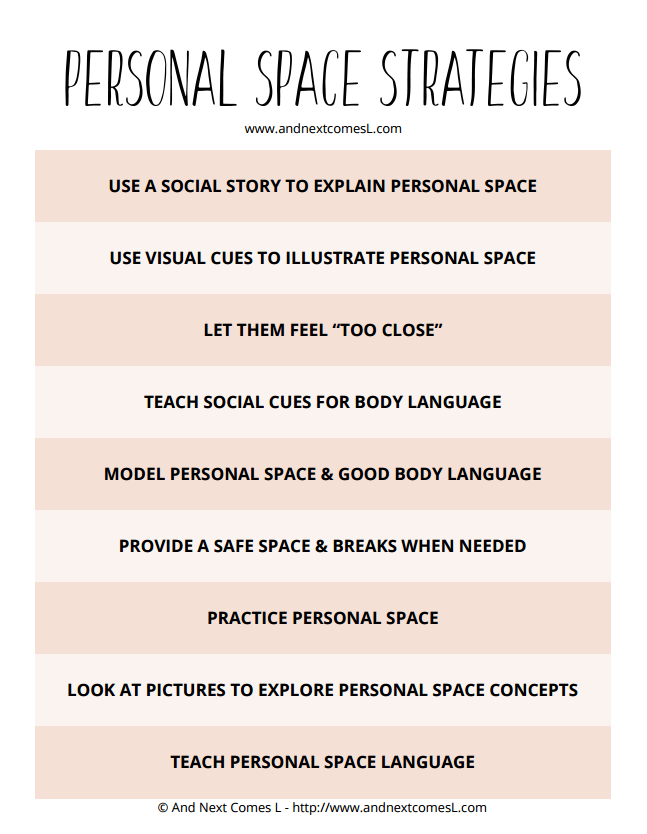Personal space is something my son really struggles with, as do most kids with autism. It's like he needs to be touching me at all times with his hands and feet or standing so close to me that I have to refocus my eyes. He basically touches shoulders with people when sitting next to them, simply unaware that he is too close and causing the person to feel uncomfortable.
However, with these 9 simple tips for teaching kids about personal space, he will be a rockstar at understanding personal space in no time and then we can check it off of our massive list of social skills to work on.
Tips for Teaching Your Kids About Personal Space
There are lots of different ways to teach kids about personal space. And let's admit it, most kids could use a bit of help when it comes to personal space, right? Here are 9 ways to teach kids about personal space. This tips work perfectly alongside the personal space social skill pack.
1. Use a social story to explain personal space
When it comes to teaching social skills to kids with autism, I'm a firm believer in a good social story. Write a social story, or at least find one, about personal space. It should outline what personal space is, what good personal space looks like, social cues for your child to look for to determine whether or not they are personal space invaders, and what to do when they need personal space.
Don't want to write a social story? No worries. I've got you covered with this personal space social story.
Click here to get the personal space social story
2. Use visual cues to illustrate personal space
Visual cues are super helpful for kids, especially those with autism and/or hyperlexia. You can use a visual clue like a hula hoop to demonstrate the invisible personal space bubbles that we all have. Or try holding a beach ball between you and your child to show how much space is needed.
3. Let them feel "too close"
Have your child slowly walk toward you, describing how he is getting closer, just right, and too close. Ask your child how they feel at each distance. When you find a distance that your child finds uncomfortable, or "too close," then explain to them that that is what others feel when he/she stands too close to them.
4. Teach social cues for body language
Make sure your child knows what to look for to determine whether they are too close or just the right distance from another person. Teach them to look for social cues such as:
- The person's face looks mad, confused, annoyed, or uncomfortable
- The person backs away
- The person puts their hands up with palms facing out
- The person avoids eye contact or starts to look elsewhere
- The person moves over or adjusts their position
- The person turns away
- The person starts to fidget or squirm
- The person's body looks stiff
5. Model personal space and good body language
Video modeling is one great option! You can simply record you and your child standing too close, just right, or too far away. Then watch the videos with your child and discuss what is expected and unexpected about each video clip.
You can also model good personal space in your everyday interactions. Remind them that they are standing too close or saying things like, "You look uncomfortable and stiff. I must be standing too close to you right now."
6. Provide a safe space and/or breaks when they need personal space
Come up with a plan for your child so that they know what to do or where they can go when they feel like they just need some space. A calm down corner or a calm down kit may be helpful for this situation. These free printable visual calm down strategies would be a helpful tool as well!
7. Practice personal space
Practice makes perfect, right? Kids can master the rules of personal space simply by practicing and repeating the skills over and over. Teach your kids the one-arm rule. That is, keep one arm length between you and your friend to maintain good personal space.
Role playing is one way to practice personal space with your kids. You could even use their favorite toys or stuffed animals to demonstrate the concepts of personal space!
8. Look at pictures to explore personal space concepts
Spend some time looking at pictures of people with your child. Talk about the body language the people are showing and whether or not good personal space is being observed.
9. Teach personal space language
Be sure to not only model personal space language, but to teach your kids some helpful personal space related language. Some example phrases could include:
- I need some space!
- That's too close!
- You can come closer!
- You're too far away right now.
- You're standing too close to me.
Download the Free Printable Cheat Sheet
To get a copy of this printable cheat sheet, click the link below:




